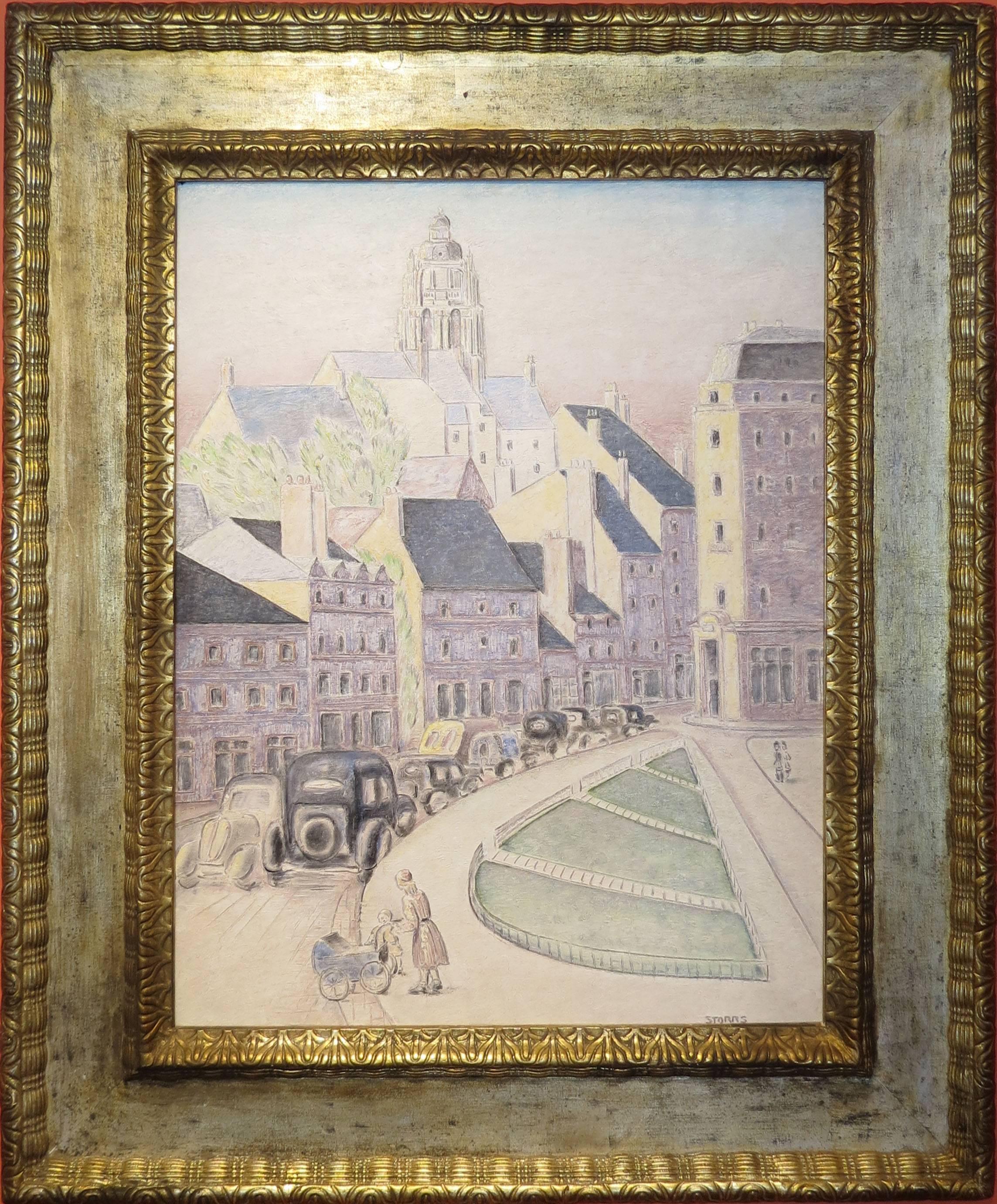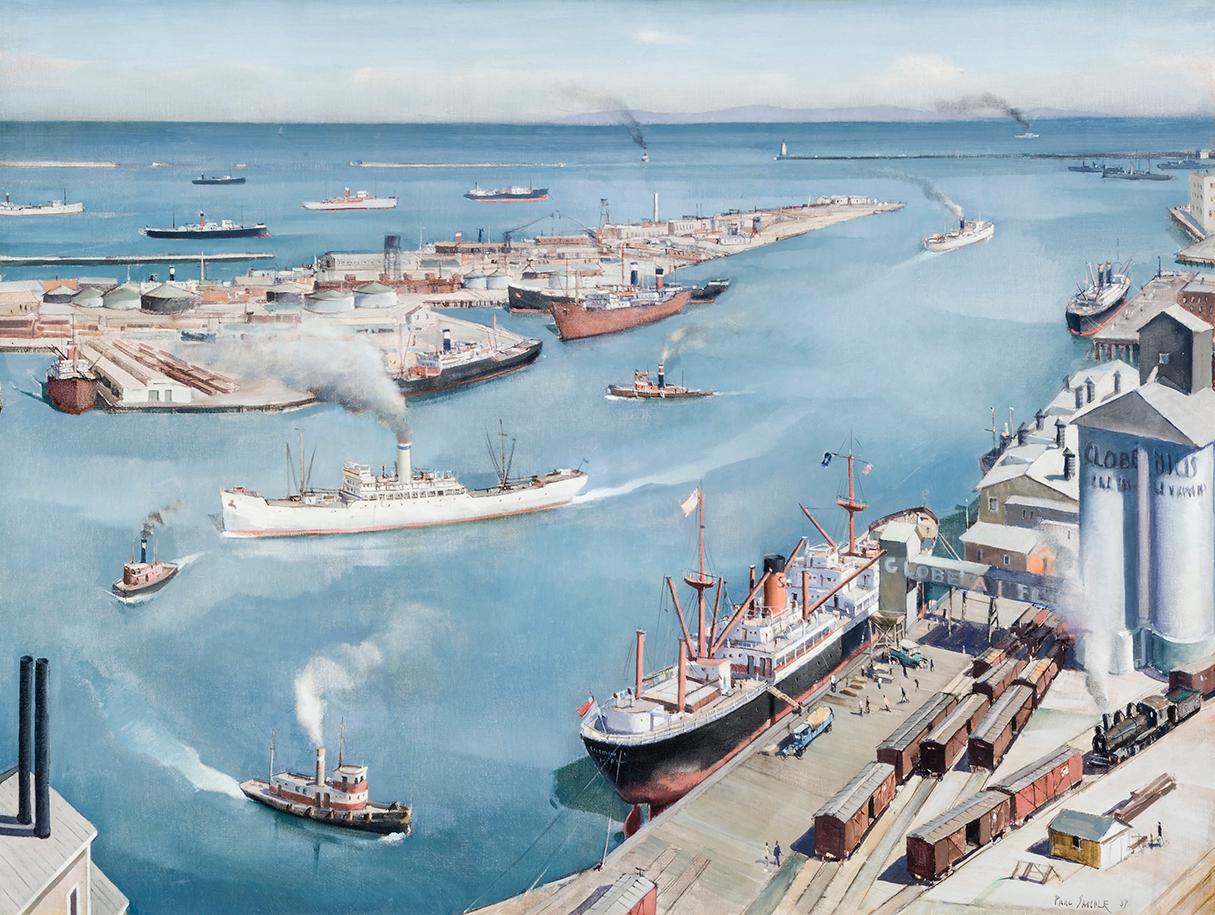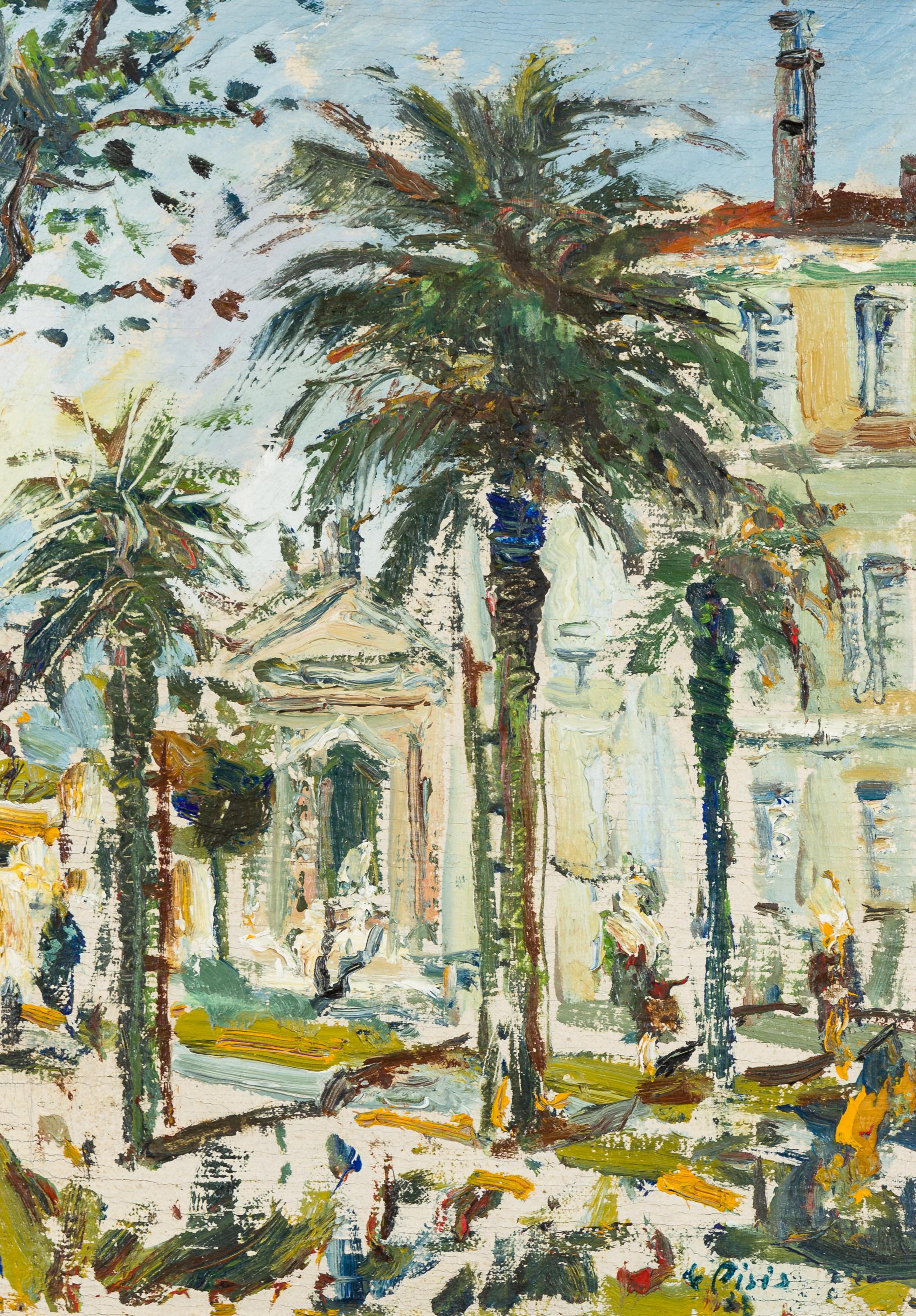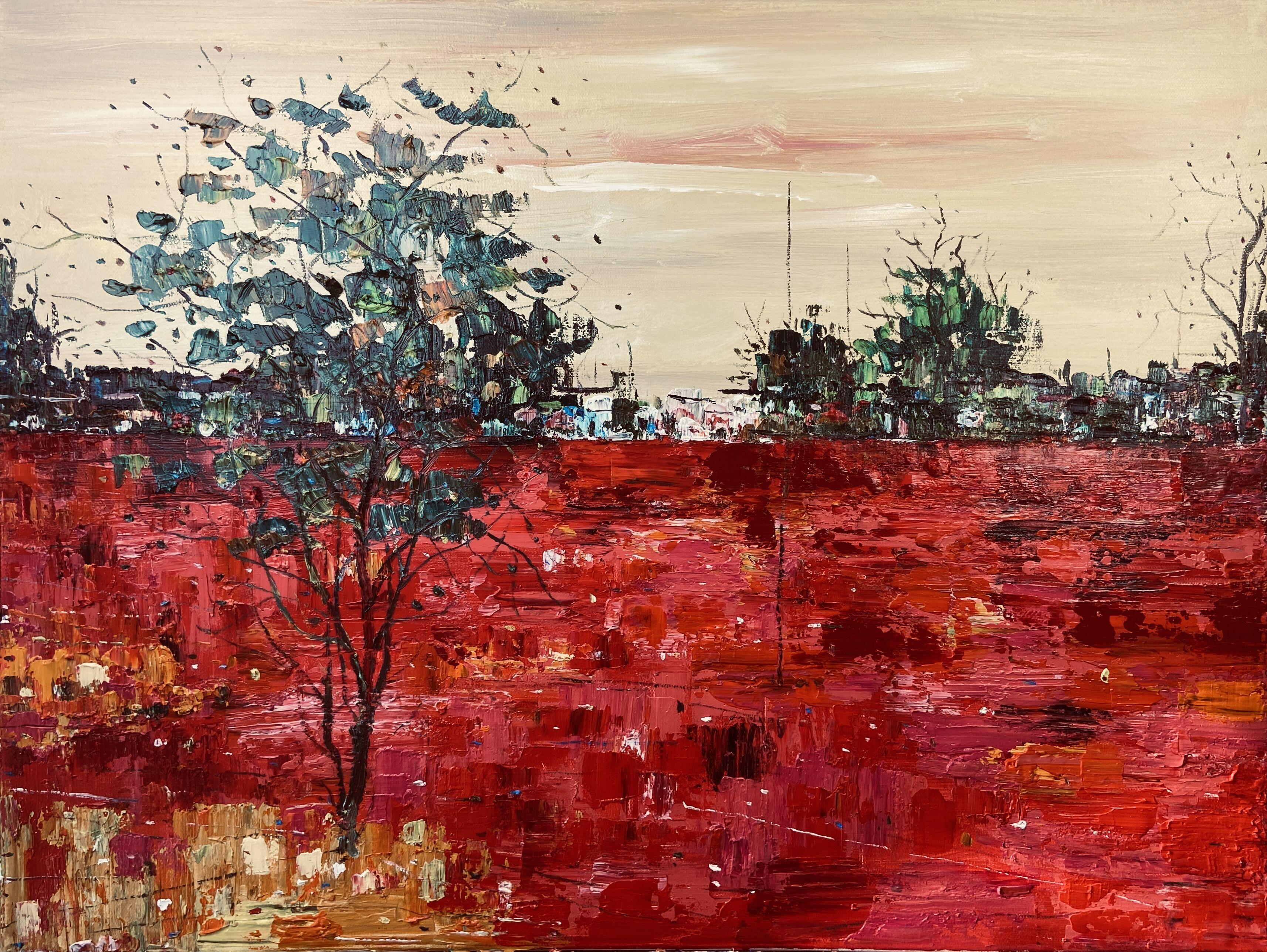Items Similar to Bandol, Cote D'Azur, South of France, Mediterranean scene
Video Loading
Want more images or videos?
Request additional images or videos from the seller
1 of 18
René GenisBandol, Cote D'Azur, South of France, Mediterranean scene
About the Item
This striking view is of the elegant town of Bandol on the Cote D'Azure which was a favourite haunt of Thomas Mann and Aldous Huxley.
René Genis (1922-2004)
Le Jardin de Bandol
Signed and inscribed with title verso
Oil on canvas, unframed
15 x 21 inches
René Genis spent the first years of his life in Vietnam before his family returned to Bordeaux in 1931. He trained initially at the Ecole des Arts Appliqués in Paris but in 1940 he fled with his family to Bordeaux where he enrolled at the Ecole des Beaux Arts. On his return to Paris, he completed his studies at the Ecole des Arts Decoratifs where he was tutored by Jules Cavailles whose influence can be seen in Genis's palette and composition.
This early grounding in applied and decorative arts is very much apparent in his work with blocks and sections of bold colour bringing to mind tapestry and ceramic design.
He exhibited extensively during his lifetime with one-man shows in Paris, New York, Tokyo and Geneva. His work is in numerous private and public collections including the Musée D'Art Moderne, Paris and Musée de L'Abbaye, Saint Claude which held a retrospective in 2008.
- Creator:René Genis (1922-2004, French)
- Dimensions:Height: 15 in (38.1 cm)Width: 21 in (53.34 cm)Depth: 1 in (2.54 cm)
- Medium:
- Movement & Style:
- Period:
- Condition:Very good, ready to hang.
- Gallery Location:Harkstead, GB
- Reference Number:1stDibs: LU1481213758682
René Genis
René Genis was born on July 26, 1922 in Hué, Annam, French Indonesia (Vietnam). Genis went with his family to Gironde, Arcachon in Bordeaux, France in 1931. Starting in 1940 he studied for five years at the Ecole des Beaux-Arts in Bordeaux, which won him a four year scholarship to the Ecole des Arts Décoratifs in Paris with Albert Marquet and Marcel Gromaire. He exhibited at the Salon de la Jeune Peinture and participated in group shows throughout France. He had his first one-man show at Galerie Charpentier in Paris in 1956. A painter, printmaker and illustrator, Genis taught at the College de Pontoise. From that time, Genis exhibited his paintings at the Salon de la Jeune Peinture, and he received the prize in 1960. For forty years, he exhibited regularly at the Salon Comparaisons in the group of Maurice Boitel. He was also a member of the Society of French Painters-Engravers. Genis is famous with his elegant still-life painting. No matter if the theme is Oriental scenery or French countryside, he always keeps a very poetry serenely ambience. With other artists like Guy Bardone, André Brasilier, Bernard Cathelin, and Paul Guiramand, Genis is also one of the important members of the Parisian Neo-Figurative School. His work has been collected by Musée d'art moderne de la ville de Paris, National Library of Paris, Fine Arts Museum of Lyon, Yamagata Museum of Art etc. René Genis was influenced by the group of poetic realists with Christian Caillard, Jules Cavaillès, Raymond Legueult, Roger Limouse, Roland Oudot, André Planson, etc. The Swiss painter Andry acknowledges being influenced by him. (Bio sourced from the Archives of AskArt - Submitted 2022 by: Jacob Frank)
About the Seller
5.0
Platinum Seller
These expertly vetted sellers are 1stDibs' most experienced sellers and are rated highest by our customers.
Established in 2002
1stDibs seller since 2021
107 sales on 1stDibs
Typical response time: 2 hours
- ShippingRetrieving quote...Ships From: Harkstead, United Kingdom
- Return PolicyA return for this item may be initiated within 7 days of delivery.
More From This SellerView All
- Orlando Greenwood, French impressionist landscapeBy Orlando GreenwoodLocated in Harkstead, GBOrlando Greenwood (1892-1989) Vaupalière Signed and dated 1927, further signed and titled verso Oil on canvas 17 x 24 inches 21 x 28 Vaupalière is a commune in the Seine-Maritime department in the Normandy region of northern France. Greenwood captures the bleaching light of high summer and sculpts the paint to draw the eye along the furrows of the field. Wonderful paint texture throughout. Orlando Greenwood was born in Nelson, Lancashire. He studied at Goldsmith's College, London before signing up with the Royal Engineers at the outbreak of the First World War. After the war he began exhibiting in London and achieved considerable success. An account of this period is summed up in the catalogue for the artist's studio sale, "At this time he was hailed by some critics as ‘undeniably brilliant’ (The Sunday Times), while the Daily Mirror...Category
1920s Modern Landscape Paintings
MaterialsOil, Canvas
- French Modernist, large Abstract view of an Almond tree with blossom flowersBy Henri-André MartinLocated in Harkstead, GBAn incredibly striking image of an almond tree in flower, the canopy of the tree dominating the whole picture space which gives an abstracted quality to the image, Painted with grea...Category
20th Century Modern Landscape Paintings
MaterialsOil, Canvas
- French Modernist, large Abstract view of Les Alpilles mountains, ProvenceBy Henri-André MartinLocated in Harkstead, GBA very striking image of an aerial view of Les Alpilles. Les Alpilles are a small mountain range in Provence, South of France. Painted with great energy and with a most appealing tex...Category
20th Century Modern Landscape Paintings
MaterialsOil, Canvas
- Harry Fidler, Impressionist study of a working Horse in farmyardBy Harry FidlerLocated in Harkstead, GBA super example of Harry Fidler's impressionist studies with characteristic use of heavy impasto. The flamboyant sculpting of the paint surface cannot be fully conveyed in a 2D image...Category
Early 20th Century Impressionist Landscape Paintings
MaterialsCanvas, Oil
- Raymond Thibésart, French Impressionist, Springtime on the banks of the SeineBy Raymond ThibesartLocated in Harkstead, GBPainted from a high vantage point on the banks of the Seine and peering though a curtain of cherry blossom, this dream like vista captures the hazy light of a spring morning. A beau...Category
Early 20th Century Impressionist Landscape Paintings
MaterialsCanvas, Oil
- Paul Madeline, Impressionist summer garden sceneBy Paul MadelineLocated in Harkstead, GBA really beautiful example of Post-Impressionist painting; the picture space filled with light and wonderfully free brushwork. A most attractive rustic image presented in very good o...Category
Late 19th Century Post-Impressionist Landscape Paintings
MaterialsCanvas, Oil
You May Also Like
- "Cityscape at Dusk"By John Bradley StorrsLocated in Lambertville, NJSigned Lower Right John Bradley Storrs (1885 - 1956) Born and raised in Chicago, John Storrs was a pioneer modernist sculptor known for his precisely executed, solid, non-objectiv...Category
20th Century Modern Landscape Paintings
MaterialsCanvas, Oil
- San Pedro HarborBy Paul SampleLocated in New York, NYIt is infrequent, to say the least, that a diagnosis of tuberculosis proves fortuitous, but that was the event, in 1921, that set Paul Starrett Sample on the road to becoming a professional artist. (The best source for an overview of Sample’s life and oeuvre remains Paul Sample: Painter of the American Scene, exhib. cat., [Hanover, New Hampshire: Hood Museum of Art, 1988] with a detailed and definitive chronology by Sample scholar, Paula F. Glick, and an essay by Robert L. McGrath. It is the source for this essay unless otherwise indicated.) Sample, born in Louisville, Kentucky, in 1896 to a construction engineer and his wife, spent his childhood moving with his family to the various locations that his father’s work took them. By 1911, the family had landed in Glencoe, Illinois, settling long enough for Paul to graduate from New Trier High School in 1916. Sample enrolled at Dartmouth College, in Hanover, New Hampshire, where his interests were anything but academic. His enthusiasms included the football and basketball teams, boxing, pledging at a fraternity, and learning to play the saxophone. After the United States entered World War I, Sample, to his family’s dismay, signed on for the Naval Reserve, leading directly to a hiatus from Dartmouth. In 1918 and 1919, Sample served in the U.S. Merchant Marine where he earned a third mate’s license and seriously contemplated life as a sailor. Acceding to parental pressure, he returned to Dartmouth, graduating in 1921. Sample’s undergraduate life revolved around sports and a jazz band he formed with his brother, Donald, two years younger and also a Dartmouth student. In November 1933, Sample summarized his life in a letter he wrote introducing himself to Frederick Newlin Price, founder of Ferargil Galleries, who would become his New York art dealer. The artist characterized his undergraduate years as spent “wasting my time intensively.” He told Price that that “I took an art appreciation course and slept thru it every day” (Ferargil Galleries Records, circa 1900–63, Archives of American Art, Smithsonian Institution, available on line). In 1920, Donald Sample contracted tuberculosis. He went for treatment to the world-famous Trudeau Sanitorium at Saranac Lake, in New York State’s Adirondack Mountains for the prescribed regimen of rest, healthful food, and fresh air. Visiting his brother in 1921, Paul also contracted the disease. Tuberculosis is highly contagious, and had no certain cure before the development of streptomycin in 1946. Even for patients who appeared to have recovered, there was a significant rate of recurrence. Thus, in his letter to Price, Sample avoided the stigma conjured by naming the disease, but wrote “I had a relapse with a bad lung and spent the next four years hospitalized in Saranac Lake.” The stringent physical restrictions imposed by adherence to “the cure” required Sample to cultivate an alternate set of interests. He read voraciously and, at the suggestion of his physician, contacted the husband of a fellow patient for instruction in art. That artist, then living in Saranac, was Jonas Lie (1880–1940), a prominent Norwegian-American painter and an associate academician at the National Academy of Design. Lie had gained renown for his dramatic 1913 series of paintings documenting the construction of the Panama Canal (The Metropolitan Museum of Art, New York; United States Military Academy, West Point, New York). Primarily a landscape artist, Lie had a particular affinity for scenes with water. His paintings, impressionistic, atmospheric, and brushy, never strayed from a realistic rendering of his subject. Sample regarded Lie as a mentor and retained a lifelong reverence for his teacher. Sample’s early paintings very much reflect Lie’s influence. ` In 1925, “cured,” Sample left Saranac Lake for what proved to be a brief stay in New York City, where his veteran’s benefits financed a commercial art course. The family, however, had moved to California, in the futile hope that the climate would benefit Donald. Sample joined them and after Donald’s death, remained in California, taking classes at the Otis Art Institute in Los Angeles. In Sample’s account to Price, “I couldn’t stomach the practice of painting a lot of High Sierras and desert flowers which seemed to be the only kind of pictures that were sold here so I got a job teaching drawing and painting at the art school of the University of Southern California.” Initially hired as a part-time instructor, Sample progressed to full-time status and ultimately, by the mid-1930s, to the post of Chairman of the Fine Art Department. Sample, however, did not want to wind up as a professor. “Teaching is all right in small doses,” he wrote, “but I have a horror of drifting into being a college professor and nothing more.” At the same time as he taught, Sample began to exhibit his work in a variety of venues at first locally, then nationally. Though he confessed himself “a terrible salesman,” and though occupied with continued learning and teaching, Sample was nonetheless, ambitious. In 1927, he wrote in his diary, “I am eventually going to be a painter and a damned good one. And what is more, I am going to make money at it” (as quoted by Glick, p. 15). In 1928, Sample felt sufficiently solvent to marry his long-time love, Sylvia Howland, who had also been a patient at Saranac Lake. The Howland family were rooted New Englanders and in summertime the Samples regularly traveled East for family reunion vacations. While the 1930s brought serious hardship to many artists, for Paul Sample it was a decade of success. Buttressed by the financial safety net of his teacher’s salary, he painted realist depictions of the American scene. While his work addressed depression-era conditions with a sympathetic eye, Sample avoided the anger and tinge of bitterness that characterized much contemporary realist art. Beginning in 1930, Sample began to exhibit regularly in juried exhibitions at important national venues, garnering prizes along the way. In 1930, Inner Harbor won an honorable mention in the Annual Exhibition of the Art Institute of Chicago. That same year Sample was also represented in a show at the Albright-Knox Gallery in Buffalo and at the Biennial Exhibition of the Corcoran Gallery of Art, Washington, D.C. In 1931, Dairy Ranch won the second Hallgarten Prize at the Annual Exhibition of the National Academy of Design, in New York. Sample also made his first appearances at the Carnegie Institute, Pittsburgh, and The Pennsylvania Academy of the Fine Arts, Philadelphia. In 1936, Miner’s Resting won the Temple Gold Medal at the Pennsylvania Academy’s Annual Exhibition. Always interested in watercolor, in 1936, Sample began to send works on paper to exhibitions at the Whitney Museum, New York. While participating in juried exhibitions, Sample also cultivated commercial possibilities. His first New York art dealer was the prestigious Macbeth Gallery in New York, which included his work in a November 1931 exhibition. In 1934, Sample joined the Ferargil Galleries in New York, after Fred Price arranged the sale of Sample’s Church Supper to the Michele and Donald D’Amour Museum of Fine Arts in Springfield, Massachusetts. In 1937, The Metropolitan Museum of Art purchased Sample’s Janitor’s Holiday from the annual exhibition of the National Academy of Design, a notable honor. As prestigious as this exhibition schedule may have been, by far Sample’s most visible presence in the 1930s and 1940s was the result of his relationship with Henry Luce’s burgeoning publishing empire, Time, Inc. Sample’s first contribution to a Luce publication appears to have been another San Pedro...Category
20th Century American Modern Landscape Paintings
MaterialsCanvas, Oil
- SanremoBy Filippo De PisisLocated in Wien, 9Filippo De Pisis, Sanremo, 1938, Oil on Canvas, 35.5 x 27 cm. Signed lower right.Category
1930s Modern Landscape Paintings
MaterialsCanvas, Oil
- The Old Monastery WallBy William S. SchwartzLocated in New York, NYSigned (at lower left): WILLIAM S. SCHWARTZCategory
Early 20th Century American Modern Landscape Paintings
MaterialsCanvas, Oil
- Figurative landscape oil painting- Red MemoryLocated in Beijing, CNDai Xiangwen was born in Hunan in 1991 and graduated from the Academy of Fine Arts of Jianghan University, He is a member of China Artists Association, China Designers Association, a painter of Li Keran...Category
2010s Modern Figurative Paintings
MaterialsCanvas, Oil
- Figurative landscape oil painting- VitalityLocated in Beijing, CNDai Xiangwen was born in Hunan in 1991 and graduated from the Academy of Fine Arts of Jianghan University, He is a member of China Artists Association, China Designers Association, a painter of Li Keran...Category
2010s Modern Figurative Paintings
MaterialsCanvas, Oil






